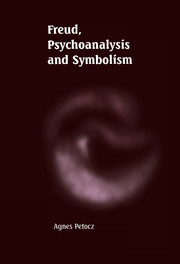Book contents
- Frontmatter
- Contents
- List of figures
- Preface
- Introduction
- Part One Exegesis and Extraction
- Part Two Consolidation and Defence
- 7 The problem of the ‘system unconscious’
- 8 The problem of language
- 9 Ernest Jones's contribution
- 10 The ‘Freudian Broad’ (FB) theory of symbolism
- 11 Symbolism: logical constraints and psychological requirements
- Epilogue
- List of references
- Index
10 - The ‘Freudian Broad’ (FB) theory of symbolism
Published online by Cambridge University Press: 22 October 2009
- Frontmatter
- Contents
- List of figures
- Preface
- Introduction
- Part One Exegesis and Extraction
- Part Two Consolidation and Defence
- 7 The problem of the ‘system unconscious’
- 8 The problem of language
- 9 Ernest Jones's contribution
- 10 The ‘Freudian Broad’ (FB) theory of symbolism
- 11 Symbolism: logical constraints and psychological requirements
- Epilogue
- List of references
- Index
Summary
I argued earlier that the weakness of the FN theory is partly the result of its having progressively become isolated from the rest of psychoanalytic theory. This isolation was reinforced by a focus on the symbol as substantive entity, and neglect of the adjectival notion of symbolic as applicable to events, actions, relations, and other phenomena more complex than a single entity. While Freud did continue to refer to these more complex phenomena in his writings, the connection between them and symbolism was not made explicit. The FB theory, in contrast, is not at all isolated from the rest of psychoanalytic theory; indeed, it is so well embedded that considerable effort is required to extract it from Freud's writings. Because it is derived from Freud's general theory, and depends for its coherence and explanatory power on the theoretical assumptions and empirical claims of that theory, understanding of the context is a prerequisite for understanding the FB theory.
That alone would be sufficient justification for including here an outline of Freud's general theory, but there are three other reasons for presenting such an outline. Firstly, it is well known that the numerous expositions of Freud's theory, even those given only in summaries and brief sketches, differ (often radically) in their ‘readings’ of the theory, and the reader must be told which of many (sometimes incompatible) versions of Freud's theory is being adopted.
- Type
- Chapter
- Information
- Freud, Psychoanalysis and Symbolism , pp. 215 - 238Publisher: Cambridge University PressPrint publication year: 1999



